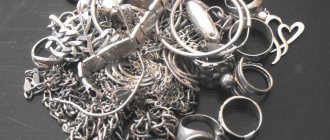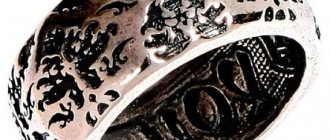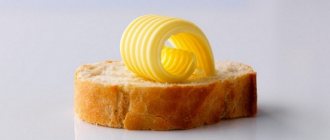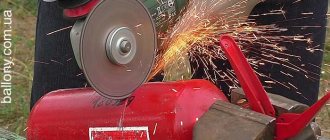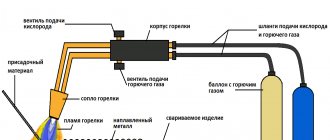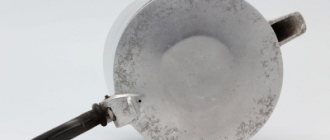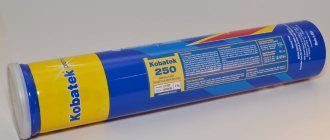Sometimes, to install exotic lenses on a camera, you have to order adapters for them from a turner. Mostly they turn me out of duralumin, aluminum and less often from steel. It is known that to increase the contrast in a photograph and to avoid stray light, you need to thoroughly blacken such a homemade adapter.
I have been looking for a long time for an acceptable method of blackening metal that could be used at home and obtain acceptable blackening quality.
The most affordable option seemed to be to buy a can of matte black paint and paint over the necessary parts. But even this method is not so simple. We need to prepare the environment, and definitely not in the apartment, but at least in the garage. And besides, the paint can be easily scratched.
I will generally keep silent about the anodizing method; it requires increased safety precautions and all sorts of experiments with sulfuric acid do not suit me.
Just recently I learned about the method of blackening with ferric chloride. Purely by chance - one person at the market said that he dips shiny parts in waste from etching printed circuit boards and thus gets a good blackening. I thought it was a good idea, but in general it’s not necessary to look for waste, it’s enough just to find ferric chloride (FeCl3) and make the same solution.
I found ferric chloride and ordered it online from a private seller on a bulletin board; a 200 g bag cost me about 50 UAH with postage.
I was pleasantly surprised, since ferric chloride is mainly sold for radio amateurs. I myself used to be interested in radio engineering, about 15 years ago, and I thought that now this industry had long been supplanted by Chinese ready-made radio solutions. It turned out that they were not forced out, since there is a supply for ferric chloride, there is also a demand. But I won’t go off topic, further on…
I ink aluminum, duralumin, steel and brass using this method. And I can say that it worked best with aluminum. The duralumin was slightly worse, but acceptable. The steel did not turn black, but became covered with a coating reminiscent of rust, it stopped shining, at least this way, it was still a little better than it was. The brass changed color a little - it became a little redder, stopped shining, became matte, but did not turn black.
aluminum bluing
Greetings to forum members, I don’t know if this topic has been raised, but I wanted to know whether it’s realistic to bury aluminum in a house.
conditions? Try Aluminum Black or Aluminox for blackening aluminum surfaces.
I’m also interested, has anyone tried to coat an MP-153 box with the following composition: Aluminum Black (the box seems to contain aluminum), is it worth taking this burnishing?
I blued it with duralumin, the effect even after thorough degreasing is poor, everything is stained, gets dirty and wears off quickly. Everything can be solved by sanding the surface and immediately applying a burnisher (before oxidation begins). Rub thoroughly in several layers, then wipe with oil. It turns out smooth, doesn’t wash off so quickly, but the coating is scratch-resistant.
I once read about this method: take egg white, let it sit for a day, then apply it to an aluminum part and let it dry. Then heat the part until red hot. After cleaning, the part will turn black. I haven’t tried it myself, I can’t say how realistic the method is.
AP topic, once again - who blued the MP-153 box with this composition?
dropped an aluminum part into a pan with “Whiteness”, the housewives add the product for washing. After 10 minutes I took it out.. it’s black, like it’s from Africa. the coating does not wear off.
drMoro
I took it out for 10 minutes... it’s black, like it’s from Africa.
Here’s a man who blued a luminium pistol with a fully written recipe and photos: https://guns.allzip.org/topic/87/376775.html
don't miss the topic, AP AP AP
On the contrary, I would like to scrub the aluminum pot. it is all black, covered in soot after 3 years of use on fires. You can wash it with anything, but it’s still blued on the outside.
akira82, well then you need to create a topic “HOW TO OPEN YOUR BOILER”)))))
The point is, rather, not in the bleach, but in the sweatpants that were in the pan
drMoro
As you say. Need data. Brand of “whiteness” (ours or imported), pure or in solution, heated or room. We know the time.
I want to give some advice to the community. It’s not really an advertisement, it’s just a person collecting orders (I ordered), including a solution for bluing aluminum, but not everyone goes to that thread. Maybe someone will be interested. https://guns.allzip.org/topic/54/890044.html
drMoro Whatever you say. Need data. Brand of “whiteness” (ours or imported), pure or in solution, heated or room. We know the time.
Not all aluminum has a blue finish. I held one sample - black. And the next day I lay there and at least fuck the village
thomas60
Not all aluminum has a blue finish. I held one sample - black. And the next day I lay there and at least fuck the village
Yes sir. for example, an aluminum basin for washing clothes turned black after adding ammonia water to soaked clothes. but a tube made of aluminum alloy ad-31 does not turn black like that. For aluminum, you need either anodizing or chemical zinc plating followed by blackening of the galvanized coating.
Source
Blackening aluminum at home (for homemade adapters)
Sometimes, to install exotic lenses on a camera, you have to order adapters for them from a turner. Mostly they turn me out of duralumin, aluminum and less often from steel. It is known that to increase the contrast in a photograph and to avoid stray light, you need to thoroughly blacken such a homemade adapter.
I have been looking for a long time for an acceptable method of blackening metal that could be used at home and obtain acceptable blackening quality.
The most affordable option seemed to be to buy a can of matte black paint and paint over the necessary parts. But even this method is not so simple. We need to prepare the environment, and definitely not in the apartment, but at least in the garage. And besides, the paint can be easily scratched.
I will generally keep silent about the anodizing method; it requires increased safety precautions and all sorts of experiments with sulfuric acid do not suit me.
Just recently I learned about the method of blackening with ferric chloride. Purely by chance - one person at the market said that he dips shiny parts in waste from etching printed circuit boards and thus gets a good blackening. I thought it was a good idea, but in general it’s not necessary to look for waste, it’s enough just to find ferric chloride (FeCl3) and make the same solution.
Search data for your request:
Aluminum is perhaps the most common metal in everyday life. In almost every home there are many small items made of aluminum, this includes various kinds of key rings, gift imitation knives, metal coatings for flash drives, etc. It is quite natural for any man to want to make his small accessories unique. For metal objects, the idea of improvement comes naturally: engraving.
Search data for your request:
Schemes, reference books, datasheets: Discussions, articles, manuals:
Precision machines
Precision machines Skip. Anodizing AL aluminum at home Everything related to painting, paints and varnishes and related tools. Attachments Hello, dear friends! At the request of friends and colleagues, I plucked up the courage and decided to write in a topic about Anodizing! Followed by coloring. Prologue: It all started a year ago, while living and working in Moscow, by the will of fate I had to return to a long-forgotten hobby, carpentry.
Little by little I had to learn carpentry, tools, equipment, accessories, etc. in a new way. One fine day, I had the opportunity to meet a good man, a carpenter in life.
And in his workshop I became acquainted with an amazing piece of equipment, a milling plate, for installing a manual milling machine into a table. So to speak, a small convenient vertical milling machine for wood. But the trouble is, these slabs produced by INCRA were delivered to our country very difficult, for a long time, and somehow not humanely.
Without moving far from the cash register, I asked myself, is it really possible that no one produces them in Russia? It turned out that they produce, but not exactly what is needed! The brothers from under heavenly China presented us with one-of-a-kind options. At the very least, I bought from them and sold from us. Everything would have been fine if not for the crisis, the double increase in rates, which completely discouraged the desire to continue to engage in this business. Well, a year has already passed, I have been producing slabs here in Russia, Dagestan, for a long time, and I think that the quality is no worse than that of others.
Because there are buyers, and since there is demand, it means the quality suits the people. What does “Warm anodizing” have to do with it, you ask, and the question has its place. And accordingly, processed aluminum has a somewhat inconvenient surface for practical use. It is not protected from external influences, from aggressive environments, and wood blanks turn black when processed on untreated aluminum.
That seems to be all. Next we will talk about the topic. If you have questions, ask questions and I will try to answer. Please note: I am not always at the computer, please be patient. The anodizing process of aluminum alloys consists of the following stages: 1. Washing parts in an organic solvent 2. Mounting parts on hangers 3. Pickling 4. Washing in hot running water 5. Washing in cold running water 6. Clarification 7. Washing in cold running water 8 .
Method of blackening aluminum with ferric chloride
I needed to blacken a couple of duralumin rings for macrofur and a couple of aluminum adapters. For such a small number of parts, 15-20 grams of ferric chloride is sufficient.
Ferric chloride in a container for preparing a solution
First you need to dilute it with a small amount of water. For such a small amount of iron, very little water is needed. It is important that the resulting mixture is thick. so that it does not spread but is spread on the surface. I did it by eye - the thicker the solution, the better.
Ferric chloride solution
While the solution is “infused,” we prepare our parts for blackening. We clean them from possible dirt and dust and degrease them. I just washed them with soap under the tap, that was enough.
Part prepared for blackening
Now that the solution is ready, take some kind of stick. for example, for cleaning ears with cotton wool on the tip. and carefully coat the inner surfaces of the adapter. I only ink them, preferring to leave them shiny on the outside. Make sure that the solution remains on the surfaces and does not run off.
Part with ferric chloride solution applied
Next, it takes a little time for the chemical reaction to take place. The duration of the reaction depends on the proportion of the solution and temperature. If you added warm water, the reaction will go faster.
In my case, the aluminum parts turned black after 7-10 minutes. The duralumin took a little longer to darken, maybe 20 minutes, but I didn’t track the exact time.
The duralumin ring has darkened
As a result, the surface became dark gray and matte. Doesn't glare, which is what we wanted.
If you are not satisfied with the result, you can rinse the parts and go through again with the remaining solution. I did this with duralumin, steel and brass, in the hope that it would turn out better.
Dural began to look noticeably better, steel and brass remained the same. You can also leave them spread for a longer time.
After achieving blackening, the parts can be washed with running water and dried. Then you can use them.
The surface of the same ring after washing and drying. I'm happy with the blackening.
After I blackened the macro bellows ring, which was initially shiny, the contrast in the photos improved a lot, especially when shooting black details with long exposures.
Another aluminum part, blackened using the same method
But what happened to the brass: It didn’t darken at all, but became dull and changed color a little
Here is a relatively simple and high-quality blackening method. I hope that it will be useful not only to me, but also to other enthusiasts.
Anodizing of parts
During the anodizing process, specialists perform preliminary mechanical processing of the aluminum profile, during which pressing defects are smoothed out (including scratches, stripes, scratches) and a matte, uniform surface is obtained.
Depending on the required surface quality of the finished metal parts, they are processed with a stream of shot or brushes made of stainless steel (grinding). In the first case, a more uniform and matte surface is obtained, in the second, the effect of a “combed” coating is achieved.
During treatment in a degreasing bath, surface contamination of the metal profile, oils and fats are eliminated.
From the profile surface during processing in an etching bath:
- aluminum oxide, which was formed under the natural influence of the environment, is removed
- foci of corrosion in the initial stage and small abrasions are etched off
As a result of anodization, optical alignment of the metal surface is achieved.
After etching in a clarification bath, all surface sludge is removed. The surface is now ready for oxidation (or anodizing process).
Then, under the influence of current (electric), a regular anode is grown. film, the thickness of which is 15-20 microns. The film grows inward and on the surface. This ensures corrosion protection and durability of the coating.
Grown anode. the film has a porous structure. It becomes hard after passing through a compaction bath containing hot water: the pores close.
To create a high-quality color film (color anodizing), before the seal bath, the aluminum profile is passed through a dye bath. The result is a porous anode. the whip acquires the required color.
Various requirements are imposed on the final quality of the processed surface of the profile, therefore the following is done:
- oxidation without mechanical treatment
- oxidation with mechanical treatment
When aluminum is anodized without pre-treatment, aesthetic requirements for the surface are achieved using chemical methods. Oxidation with mechanical processing allows you to obtain high-quality special effects on the surface of a metal profile.
Blackening aluminum at home: means, methods, procedures, tips
Due to the fact that most steel grades are susceptible to corrosion, they begin to rust when in contact with water. This can also happen if the product is placed in a room with high humidity. Of course, the corrosion process can be prevented if the steel surface is wiped dry every time. Anti-corrosion paint is mainly applied to metal products using a brush or by spraying.
However, this is not a solution to the problem if the design includes threaded connections or moving parts. The best option in such cases would be the bluing process. Despite the fact that rust does not form on aluminum, judging by the reviews, it happens that the owner wants to blacken this metal. This procedure can also be recommended for this purpose. It is also called blueing. But if we adhere to technical terminology, then this process is more correctly called oxidation. How to blacken aluminum? What will you need for this? You will find information on how to blacken aluminum at home in this article.
What is the essence of the procedure?
Before you start blackening aluminum at home, you should understand what the meaning of this process is. According to experts, its essence is to create conditions in which a film of iron oxide would form on a metal surface. Depending on which method of aluminum bluing was chosen, its thickness can range from 1 to 10 microns. There are three ways to influence metal. Consequently, blackening of aluminum at home can be thermal, acidic or alkaline. In the first case, the product is heated, and in the other two it is processed in an appropriate solution. During bluing, the tarnish colors on the surface will change. The master only needs to decide on the desired color of oxidation and stop the process in time.
Application of ferric chloride in industry and public utilities. Household use
Iron salts are used in many fields. Trivalent metal chloride is used to treat water, metals and paints. The substance is used in industrial organic synthesis (catalyst, oxidizer). The coagulating properties of the Fe3+ ion are especially appreciated in the treatment of municipal and industrial wastewater. Under the influence of ferric chloride, small insoluble particles of impurities stick together and precipitate. Also, some of the soluble contaminants are bound, which are removed at wastewater treatment plants. Crystalline hydrate and anhydrous salt FeCl3 are used in etching processes of metal printing plates. A substance is added to concrete to strengthen its strength.
About ferric chloride
Judging by the reviews, some home craftsmen etch printed circuit boards and thus obtain a liquid for blackening aluminum. Next, shiny metal parts are lowered into this mining for a certain time. Those who are interested in how to blacken aluminum at home can be advised not to complicate the process by etching the boards, but to immediately acquire ferric chloride to make the required solution. You can work with this method both with aluminum and with duralumin, steel and brass.
Judging by the reviews, aluminum surfaces are best blackened. With duralumin the situation is somewhat worse. Steel ones, according to the craftsmen, practically do not blacken. However, they develop a specific coating that can be confused with rust. However, the steel surface is no longer so shiny and looks much better. Brass products after treatment in ferric chloride also do not become black, but acquire a matte reddish tint.
How to burnish with iron chloride? Where to begin?
If small-sized aluminum products are to be processed, then you can limit yourself to 15-20 grams of this substance. Blackening aluminum at home using ferric chloride consists of several stages. First of all, you should prepare everything for work. First, ferric chloride is diluted with water. It is important that the mixture is easy to spread. To make it thick and not spread, you need to take a small amount of water. Next, the solution must be given time to brew. During this time, you can prepare the product itself for bluing: remove dirt and dust from its surface, and then degrease it. Judging by the reviews, it is enough to wash it under the tap with soap.
General recommendations
Aluminum is a soft metal that requires careful handling during operation and cleaning. To clean products from various types of contaminants and not damage the material, follow simple recommendations:
- Do not use metal scrapers or brushes, hard scourers or sharp objects . These tools damage the surface, leaving scratches and other unsightly marks. After such treatment of the dishes, aluminum particles can get into the food, which will negatively affect the taste of the dish and its benefits.
- Do not clean aluminum alloy products with abrasive agents (sand, powder).
- Kitchen utensils should be washed only after they have cooled down . Hot metal deforms when interacting with water, and it is almost impossible to return its original appearance on your own.
- such as acids or alkalis for cleaning They spoil the aesthetic appearance, and the resulting chemical reaction can lead to the release of toxins or heavy metals that are hazardous to health.
- To achieve the desired effect, choose a cleaning method and cleaning product based on the type and degree of contamination .
- Do not wash aluminum cookware in the dishwasher . Temperature changes negatively affect the metal and increase the risk of deformation and corrosion.
- To make the product shiny, polish the surface with a sponge dipped in a solution made from borax and ammonia in a ratio of 3:1.
Aluminum products require a special approach to cleaning and operation to avoid deformation, scratches and irreversible damage
Do not wash aluminum cookware in the dishwasher.
Progress
If the solution is prepared and the aluminum surface is cleaned, you can proceed directly to bluing. You will have to work with a stick with cotton wool wound at one end.
Using this stick, scoop up the mixture and apply it to the desired area. At the same time, you need to make sure that it does not spread, but remains in place. Afterwards, the product should be left for some time, without interfering with the chemical reaction. To make it flow faster, experts recommend diluting ferric chloride with warm water. According to home craftsmen, aluminum will turn black within 10 minutes. Aluminum products will have to be burnished longer - the chemical reaction will take half an hour.
↑ Making a photo template
Next, use any convenient program to prepare a photo template and print it on transparent film for printers. When printing, we indicate the maximum contrast and minimum brightness, but here you have to try. I have an Epson RX610. The settings are as follows: print quality “Best Photo”, “Shades of Gray”, paper type “Epson Matte”, brightness: -25, contrast +25. Photoresist is negative! That is, where there is no paint on the template, the photoresist will glow and will not wash off during development! Be careful.
Rice. 5. Photo template. I use film sparingly. Therefore, I print different projects on one sheet while there is space left.
How to blacken with olive oil and egg white?
The essence of this method is as follows. First, the aluminum part is carefully polished with fine-grained sandpaper. Next, it is degreased in a soda solution. Then olive oil is applied to the product and heated using an alcohol lamp. It is very important that the flame does not produce soot. Heat treatment should be carried out until a black color appears on the surface. During this time, the oil will burn out and will have to be reapplied. According to experts, the part will have to be lubricated often. Afterwards the surface is cooled and wiped thoroughly. The method using an egg is practically no different from this procedure. The only difference is that it is not olive oil that should be applied to the surface, but beaten egg white. It is advisable that it sit in a warm place for a couple of days before bluing. When it dries sufficiently on the part, it begins to be heated until red hot. At the end, the protein should fall behind, and the aluminum underneath will turn black.
Black oxide coating on aluminum and alloys
The method, outlined in the US patent, forms a layer of black oxide on the surface of aluminum or an aluminum alloy during just one processing step .
1. In the proposed technology, the surface on which the black oxide layer is to be formed is first cleaned to remove any oils and other components that may interfere with the formation of the oxide layer.
2. After cleaning, the surface is rinsed with tap water and then immersed for 30 minutes in the below solution, maintained at a temperature of 80°C to 90°C. The result is an acceptable black oxide layer having a thickness of about 500 A.
3. After treatment, the surface is washed with distilled water and then dried with air at room temperature.
Compositions of solutions for chemical oxidation of aluminum and aluminum alloys:
| Tolyltriazole | 0.05-0.8 g |
| Sebacic acid | 0.2-1.5 g |
| Hexanoic acid | 15-50 milliliters |
| Sodium chloride | 1.6-3.2 grams |
| Sodium sulfate | 1.5-3.0 grams |
| Bicarbonate of soda | 1.4-2.8 grams |
| Sodium silicate | less than 0.2 grams |
| Ethylene glycol | 20-80 milliliters |
| Distilled water | balance |
| Sodium hydroxide | If necessary. maintain pH at 7.5-8.5; T 80-90 ° C |
| Dibasic sodium phosphate | 5-12 grams |
| Sodium benzoate | 5-12 grams |
| Sodium molybdate dihydrate | 0.5-1 gram |
| Sodium chloride | 4.G-6.0 grams |
| Sodium sulfate | 3.5-5.5 grams |
| Bicarbonate of soda | 3.5-5.5 grams |
| Distilled water | balance |
| Sodium hydroxide | If necessary, maintain pH at 8.0-9.0 at 80-90 ° C. |
It is important to note that both methods provide a black coating not only on aluminum, but also on a variety of its alloys, including aluminum-manganese alloys (e.g. AA 3102), aluminum-silicon alloys (e.g. AA 4047) and aluminum-zinc alloys (e.g. ,AA 7072).
Source
About copper plating
A galvanic method is provided for surface painting. Thanks to the copper layer, the product will be more attractive in appearance. This explains why copper plating is used predominantly in design projects. In addition, the copper layer provides the metal with high electrical conductivity. Copper plating can be the main process, the task of which is to create a surface layer. This galvanic method is also used as an intermediate operation when it is necessary to apply another metal layer to the surface. For example, if you need to perform silver plating, chrome plating and nickel plating.
Receipt
Methods for producing acetic acid:
- from acetaldehyde by oxidation with atmospheric oxygen in the presence of a Mn(CH3COO)2 catalyst and high temperature (50-60°C) – 2CH3CHO + O2 → 2CH3COOH;
- from methanol and carbon monoxide in the presence of catalysts (Rh or Ir) – CH3OH + CO → CH3COOH;
- from n-butane by oxidation in the presence of a catalyst at a pressure of 50 atm and a temperature of 200°C – 2CH3CH2CH2CH3 + 5O2 → 4CH3COOH + 2H2O.
Rice. 2. Graphic formula of acetic acid.
The fermentation equation is as follows – CH3CH2OH + O2 → CH3COOH + H2O. The raw materials used are juice or wine, oxygen and enzymes from bacteria or yeast.
What will you need for work?
According to experts, you can blacken aluminum using this method at home. However, first you need to acquire the necessary equipment and materials. First of all, prepare a source of electric current. A KBS-L battery rated at 4.5 volts is quite suitable for this purpose. Some craftsmen recommend 9-volt Krona batteries. You can also use a car battery or a low-power 12-volt rectifier.
To be able to regulate and smoothly stop the process, you will need a rheostat. The electrolyte solution will be contained in a neutral glass container or wide plastic container. It will be possible to supply current to the solution through anodes.
How to prepare the solution?
For high-quality electroplating you need to stock up on the following chemicals:
- Copper sulfate. 20 g will be enough.
- Hydrochloric or sulfuric acid (2-3 ml).
To prepare an electrolyte solution, these substances are dissolved in distilled water. Experts advise using at least 1 liter. Read more about how to blacken aluminum with copper sulfate at home.
Process description
Judging by the reviews, the procedure will go without problems if you follow the following sequence of actions. First of all, the part is cleaned and degreased. Then the product must be lowered into an empty container. Now you can connect the negative terminal to the aluminum. An electrolyte solution is prepared in a separate container. Next, the insulation is removed from one end of the stranded copper wire. It should look like a brush.
The other end of the wire is connected to the positive terminal. The blackening procedure consists of moistening the brush in the prepared solution and passing it over its surface without touching the workpiece. Finally, the aluminum product is washed and dried.
Source

